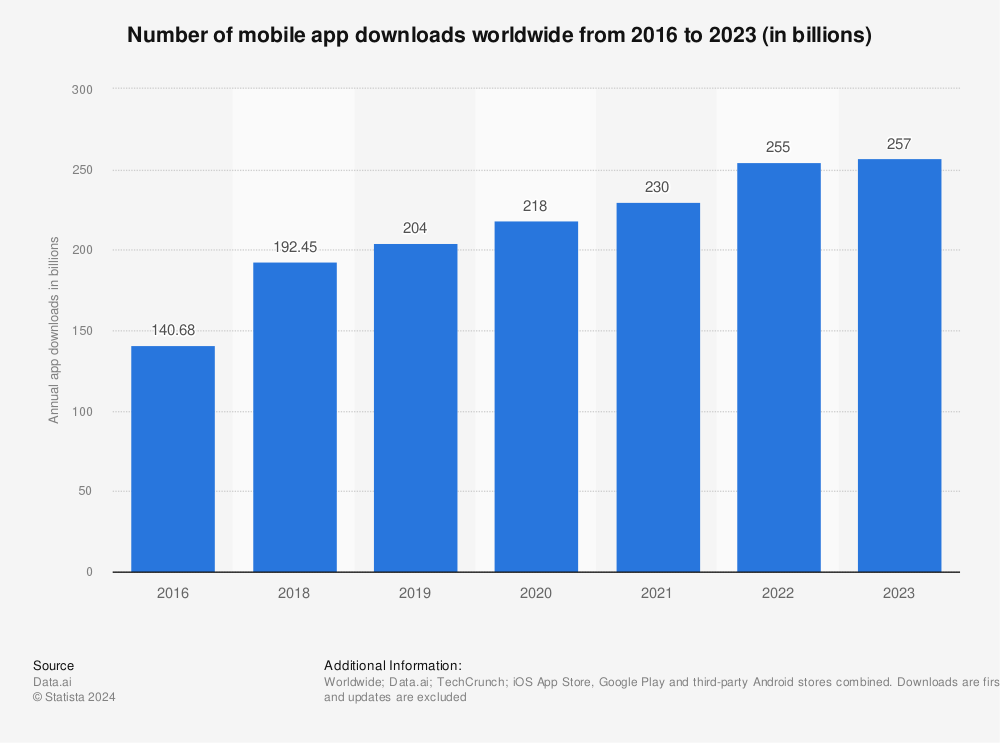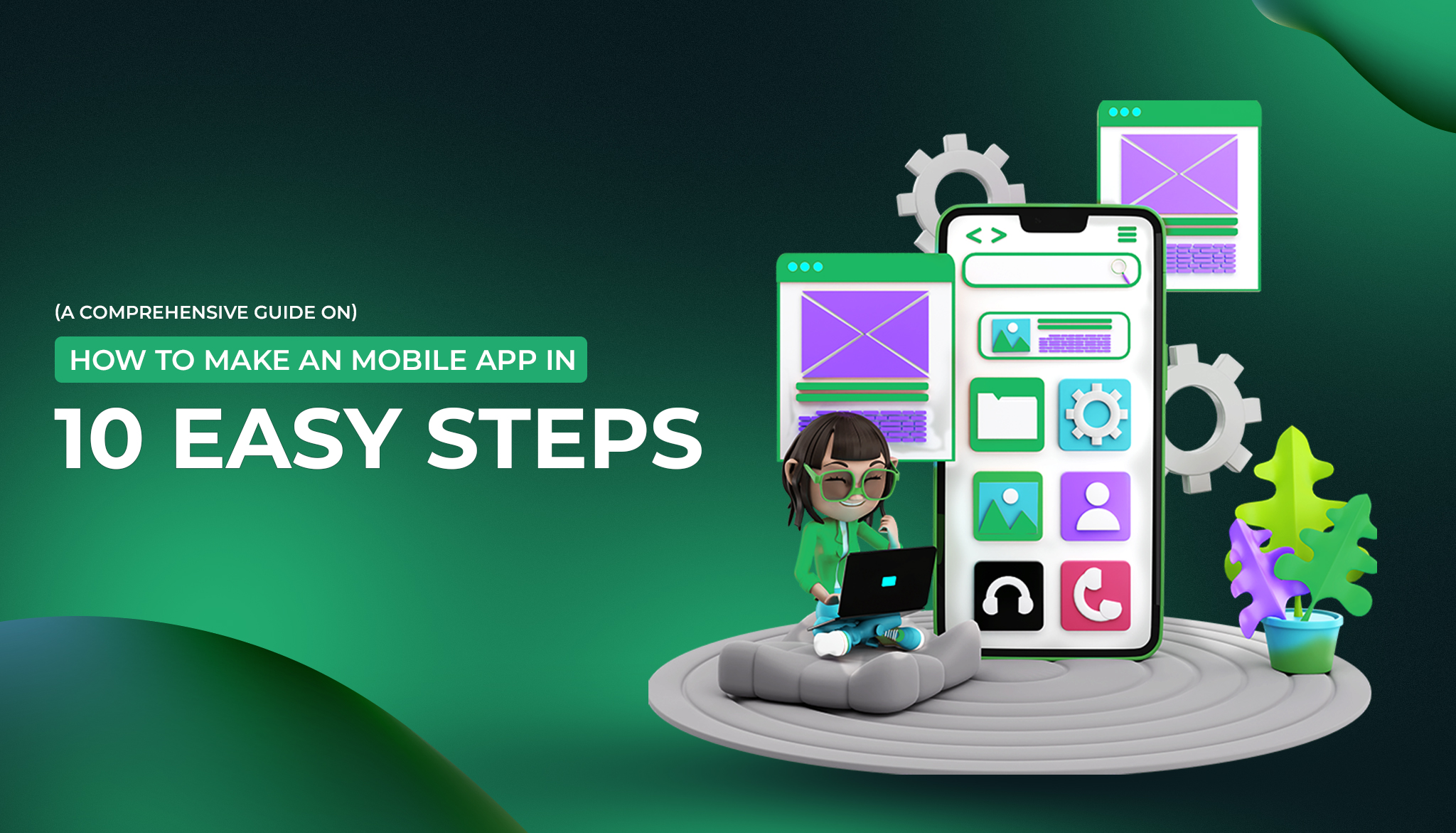Back when smartphones were new to the market and app development was in its early stages, anyone looking to create a mobile app needed a large budget and strong coding knowledge, or they needed the help of a professional mobile app development company. Now, fast forward to the present day, and mobile apps have become an essential part of our daily lives. From our pockets to our tablets to even our fridges, they are a part of our daily routines, influencing how we work, communicate, and navigate the world around us.
85% of companies now offer mobile applications, it’s clear that apps are more than just a temporary phenomenon.
Overview of the Mobile app industry.
The mobile app industry is getting bigger and bigger. As the production of featured smartphones and app users increases, the demand for new and innovative apps is growing exponentially. According to Statista, the global mobile app market is estimated to reach $756 Billion by 2027 at a Compound annual growth rate(CAGR) of 8.58% during 2022-2027.
Users look for innovative and feature-rich apps for multiple purposes, as a result, this has broadened the business scope for launching more user-focused apps. Startups, small businesses, SMEs, and enterprises are investing a considerable chunk in mobile app development to build customer-orientated apps.

Source: Statista
- Global consumer spending on mobile applications has touched $129B as of 2022.
- During 2019-2020, more than 250 million mobile apps were downloaded daily.
- The global mobile app development market size is poised to attain $583.03 Billion value at a CAGR of 12.8% during the 2022-2030 period.
- There are a total of 5.7 million apps on the Google Play Store and Apple App Store.
- On average, smartphone users spend around 4-5 hours a day using mobile apps.
- China and India are the top countries that have the highest number of mobile app users.
What to Choose: In-House Development or a Mobile App Development Company?
This option has a significant impact on one’s app development journey. Each option, whether in-house or through a mobile app development company, offers both advantages and disadvantages. As we move forward; we will look at the elements that might help you make an informed decision and ensure the success of your mobile app project.
Why the Decision Matters
The decision between in-house development and hiring a custom mobile app development company is more than just personal preferences; it has a significant impact on the direction of your project. Cost, experience, control, and timing become important considerations, necessitating a careful weigh-in of the benefits and negatives.
In-House Development:
Choosing in-house development provides more control over the entire app development process. Your in-house team will focus only on your project, resulting in a deep and thorough understanding of your business objectives and more smooth collaboration. While the initial cost of establishing an in-house team may be higher, the long-term benefits in terms of control and personalization can be significant.
Mobile app development Company:
Choosing a mobile app development company adds additional experience to the table. These organizations specialize in making ideas into reality, with experienced personnel handling and monitoring every stage of the development process. While it may require less hands-on control, the efficiency, experience, and typically shorter time-to-market can overcome this factor. The outsider perspective also provides new insights and creative approaches to the app.
Things to know before you start:
Understanding the fundamental aspects of your app is a must before you start the development process, from defining your app’s purpose to assembling a skilled development team or partnering up with the right mobile app development firm.
1. Define Your objective:
Define the objective of your mobile app before focusing on technical details. Whether it’s improving internal operations, providing a customer service channel, or offering a product or service, a clear objective is important for future development decisions.
2. Identify Your Target Audience:
Knowing your target audience is extremely important. A solid understanding of their demographics, preferences, and behaviors ensures that your software is personalized to their needs, increasing its significance and usability.
3. Choose a Platform:
Determine whether your app will target iOS, Android, or both. Each platform has unique characteristics, and the one you choose should be compatible with your intended audience. Consider a cross-platform approach to increase your app’s accessibility.
4. Understand Development Costs:
Awareness of potential costs is crucial. In an in-house development model, Upfront costs may be higher due to hiring and infrastructure setup, and when choosing to go with a mobile app Development Company, the Initial costs may be more manageable, and you can also pick a pricing model that fits your budget.
How to develop an app in 10 steps:
Whether you choose in-house development or opt for a mobile app development company, the success of your project relies on a well-defined and strategic development process. Let’s look at the 10 essential steps to guide you through the app development lifecycle.
1. Establish a Team
If you opt for in-house development, it is crucial to assemble a good team before getting into the technical aspects, at minimum, your app development team should include a:
Product Manager: Develops technical spec documents, roadmaps, and deadlines, gathers requirements, and guides the team accordingly.
UX/UI Designer: Designs graphics, icons, and animations to ensure the app is engaging and highly intuitive.
Mobile Developer: Codes functionality, integrating APIs, databases, and more.
Quality Assurance Analyst: Tests the app on various devices, identifying bugs, and any potential errors, to ensure smooth operation of the app.
Digital Marketer: Assists in a successful app launch through SEO and mobile analytics.
Alternatively, if you are partnering with a mobile app development company, conduct extensive research on their previous projects to ensure credibility and a track record of successful projects.
2. Conduct Competitive Research
Thoroughly research the market to understand competitor’s features and customer requirements. Identify what works well and where there’s room for improvement. This research informs you about the gaps in the market that you want to fill and those become your app’s unique selling points.
3. Outline Core Features
Define the essential features your app will offer. Ensure they align with user needs and expectations and also the business expectations. A user-centric approach at this stage contributes to the overall success of your app down the line.
4. Create Mockups
Visualize your app’s layout, design, and user interface by creating mockups. This step bridges the gap between conceptualization and actual development, providing a real tangible representation of your app’s potential.
5. Plan App Security
Security is very important when it comes to custom app development. Prioritize the implementation of robust security measures to protect user data. Ensure compliance with relevant regulations, fostering trust with your users.
6. Begin Coding
When all the kinks have been ironed out and with a solid plan in place, proceed to code the front-end (user interface) and back-end (server-side logic). Coordination between these elements ensures a seamless and responsive user experience. Adopt an Agile methodology for an efficient development process.
7. Perform Multiple Tests
Quality assurance is a necessary part of any custom app development lifecycle, test your app across various devices, operating systems, and scenarios. Address bugs, glitches, and performance issues as soon as they arise. User acceptance testing ensures your app meets the expectations of your audience.
8. Gather and Implement Feedback
Launch a prototypical version of your app, focusing on core functionalities. Gather user feedback and iterate on your app based on real-world usage and evolving user needs. Continuous improvement keeps your app fresh and aligned with user’s needs.
9. Launch the App
Launch your app on the chosen platform(s), either the IOS App Store or Google Play Store. Ensure compliance with the respected app store’s requirements. Monitor app performance, and user behavior, and gather analytics for further insights to improve upon.
10. Promote the App
Implement a marketing strategy to promote your app. Leverage digital marketing channels like social media, and other platforms to increase the visibility of your application. Engage with your target audience and create awareness about your app.
Conclusion
Developing a mobile app is a complex process that involves careful planning and execution. Each phase is important to ensure the overall success of your project. Whether you’ve chosen to go with an in-house team or partnered with a mobile app development company, the above-mentioned ten phases will be essential in making your concept into a fully functional and user-friendly mobile application.


